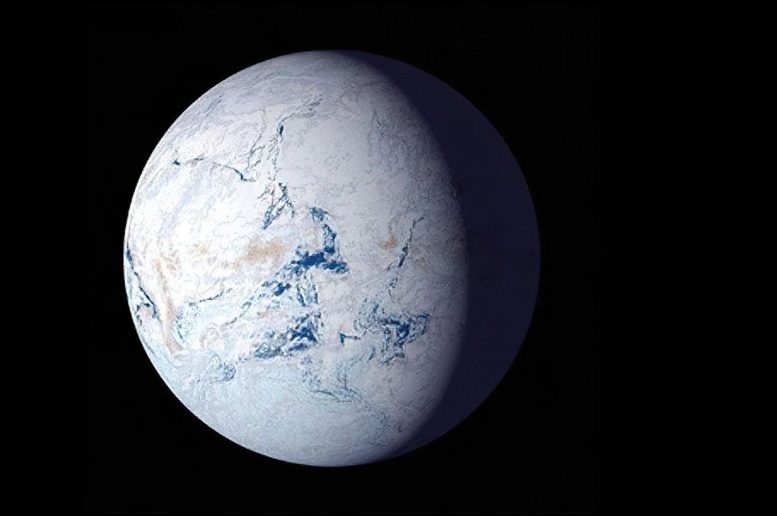
Australian geologists have identified low volcanic CO2 emissions and rock weathering in Canada as key factors behind an extreme ice age 700 million years ago. Their research, informed by plate tectonic modeling and geological evidence from South Australia, sheds light on Earth’s climate sensitivity and its natural thermostat mechanisms, contrasting the slow pace of geological climate change with the rapid changes driven by human activities. Credit: NASA
Volcanic carbon emissions reached an all-time low, triggering a global ice age that lasted for 57 million years.
Australian geologists employed plate tectonic modeling to identify the most likely causes of an extreme ice-age climate on Earth, occurring over 700 million years ago.
The study, published in Geology, helps our understanding of the functioning of the Earth’s built-in thermostat that prevents the Earth from getting stuck in overheating mode. It also shows how sensitive global climate is to atmospheric carbon concentration.
“Imagine the Earth almost completely frozen over,” said the study’s lead author, ARC Future Fellow Dr Adriana Dutkiewicz. “That’s just what happened about 700 million years ago; the planet was blanketed in ice from poles to the equator and temperatures plunged. However, just what caused this has been an open question.
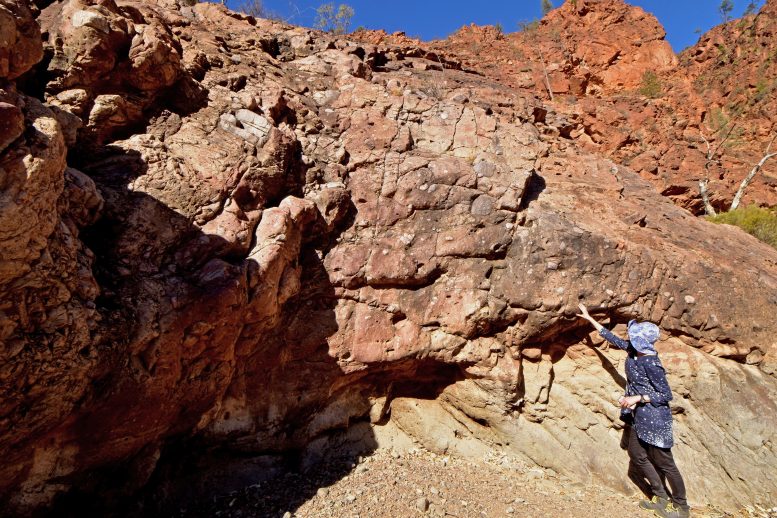
Sturt Formation glacial deposits from the Sturtian Glaciation circa 717–664 million years ago in the northern Flinders Ranges, Australia, close to the Arkaroola Wilderness Sanctuary. Research lead author Dr Adriana Dutkiewicz from the School of Geosciences, the University of Sydney, pointing to a thick bed of glacial deposits. Credit: Professor Dietmar Müller/University of Sydney
“We now think we have cracked the mystery: historically low volcanic carbon dioxide emissions, aided by weathering of a large pile of volcanic rocks in what is now Canada; a process that absorbs atmospheric carbon dioxide.”
Geological Insights from the Flinders Ranges
The project was inspired by the glacial debris left by the ancient glaciation from this period that can be spectacularly observed in the Flinders Ranges in South Australia.
A recent geological field trip to the Ranges, led by co-author Professor Alan Collins from the University of Adelaide, prompted the team to use the University of Sydney EarthByte computer models to investigate the cause and the exceptionally long duration of this ice age.
Between 717 and 660 million years ago, the Earth was covered in snow and ice – a 57 million-year ice age. University of Sydney geoscientists, led by Dr Adriana Dutkiewicz and Prof Dietmar Müller, have found the likely cause: all-time low levels of volcanic carbon dioxide in the atmosphere. This video shows motions of continents (grey) and plate boundaries (orange) from 850 to 540 million years ago. (Snowflakes appear during the ‘Snowball Earth’ periods.) Credit: Ben Mather and Dietmar Müller/The University of Sydney
Sturtian Glaciation and Plate Tectonics
The extended ice age, also called the Sturtian glaciation after the 19th-century European colonial explorer of central Australia, Charles Sturt, stretched from 717 to 660 million years ago, a period well before the dinosaurs and complex plant life on land existed.
Dr Dutkiewicz said: “Various causes have been proposed for the trigger and the end of this extreme ice age, but the most mysterious aspect is why it lasted for 57 million years – a time span hard for us humans to imagine.”
The team went back to a plate tectonic model that shows the evolution of continents and ocean basins at a time after the breakup of the ancient supercontinent Rodina. They connected it to a computer model that calculates CO2 degassing of underwater volcanoes along mid-ocean ridges – the sites where plates diverge and new ocean crust is born.
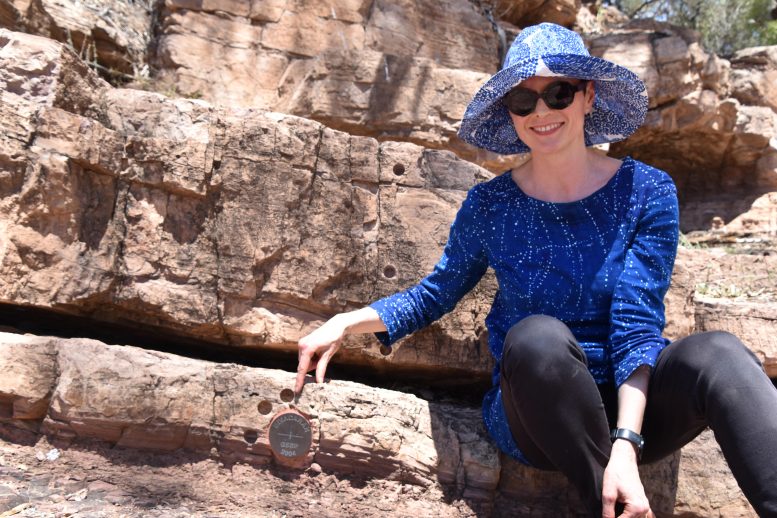
Dr Adriana Dutkiewicz from the School of Geosciences at the University of Sydney in the Flinders Ranges, South Australia. Credit: The University of Sydney
The Role of CO2 and Geological Climate Change
They soon realized that the start of the Sturtian ice age precisely correlates with an all-time low in volcanic CO2 emissions. In addition, the CO2 outflux remained relatively low for the entire duration of the ice age.
Dr Dutkiewicz said: “At this time, there were no multicellular animals or land plants on Earth. The greenhouse gas concentration of the atmosphere was almost entirely dictated by CO2 outgassing from volcanoes and by silicate rock weathering processes, which consume CO2.”
Co-author Professor Dietmar Müller from the University of Sydney said: “Geology ruled climate at this time. We think the Sturtian ice age kicked in due to a double whammy: a plate tectonic reorganisation brought volcanic degassing to a minimum, while simultaneously a continental volcanic province in Canada started eroding away, consuming atmospheric CO2.
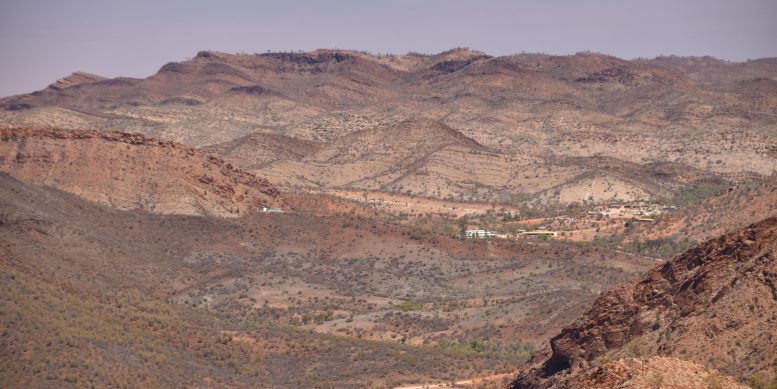
View towards the Arkaroola Wilderness Sanctuary, Flinders Ranges, with the Sturt Formation glacial deposits from the Sturtian Glaciation circa 717–664 million years ago forming a prominent ridge in the middle of the photo on the left. Credit: Professor Dietmar Müller/University of Sydney
“The result was that atmospheric CO2 fell to a level where glaciation kicks in – which we estimate to be below 200 parts per million, less than half today’s level.”
The team’s work raises intriguing questions about Earth’s long-term future. A recent theory proposed that over the next 250 million years, Earth would evolve towards Pangea Ultima, a supercontinent so hot that mammals might become extinct.
However, the Earth is also currently on a trajectory of lower volcanic CO2 emissions, as continental collisions increase and the plates slow down. So, perhaps Pangea Ultima will turn into a snowball again.
Dr Dutkiewicz said: “Whatever the future holds, it is important to note that geological climate change, of the type studied here, happens extremely slowly. According to NASA, human-induced climate change is happening at a pace 10 times faster than we have seen before.”
Reference: “Duration of Sturtian “Snowball Earth” glaciation linked to exceptionally low mid-ocean ridge outgassing” by Adriana Dutkiewicz, Andrew S. Merdith, Alan S. Collins, Ben Mather, Lauren Ilano, Sabin Zahirovic and R. Dietmar Müller, 7 February 2024, Geology.
DOI: 10.1130/G51669.1
The study was funded by the Australian Research Council.








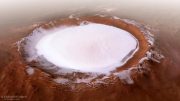
What apparently isn’t appreciated is that the evidence of tillites (lithified glacial tills) isn’t found everywhere and continuously. Geologists are extrapolating, assuming that glaciation happened everywhere at the same time, despite large gaps in the exposure of the tillites. Also, unlike marine sediments, terrestrial rocks don’t provide clear-cut evidence for their elevation at the location for the time of deposition. It takes a ‘Leap of Faith’ to assume that a particular outcrop is representative of what happened everywhere on Earth. The tillites exposed today could be from alpine glaciers, which have been preserved by large down-drops of crustal blocks called “graben.”
A problem with the modeled ‘Ice House,’ is that the Large Igneous Province in ‘Canada,’ would have super-charged the atmosphere with CO2, a necessary prerequisite to create the carbonic acid required to chemically weather the lava and return the atmospheric level back to its original concentration. The release of CO2 would have come from the volume of the volcanic pile, while the weathering of the lava, consuming the atmospheric CO2, would have been confined to the exposed surface (hopefully not covered with ice), meaning that the reduction would have been slower than the release. Besides that, is there a large deposit of carbonates to support the Gondwana weathering claim? ALL the evidence has to support a hypothesis, not just the convenient, supporting evidence.
“A recent theory suggested that the Earth might evolve into a supercontinent called Pangea Ultima in the next 250 million years, which could be so hot that mammals would die out.”
It is a simplistic extrapolation based on average temperatures predicted by problematic models. Assuming that there is even any validity to the idea of another supercontinent, it overlooks what is called the ‘lapse rate,’ which is how much the temperature decreases with elevation. That means that there will be refugia in mountain ranges where mammals would survive. Also, the coasts would probably be cooler than the interior, not unlike present day Australia. Small mammals at lower elevations might become nocturnal, and larger animals become more migratory. Even now, it is common for many species to move back and forth between hot and cold zones. It is ‘hand waving’ by someone who is craving attention.
“The result was that atmospheric CO2 fell to a level where glaciation kicks in – which we estimate to be below 200 parts per million, less than half today’s level.”
However, there is strong evidence that the late-Cenozoic/Pleistocene glaciation is controlled by the Milankovitch Cycles, not CO2, and the CO2 may even lag temperature by about 800 years.
From doi: https://doi.org/10.1130/G51669.1
“The two plate motion models diverge in their predictions of the timing and progression of Rodinia break-up, ocean-basin age, ocean-basement depth, sea-level evolution and mid-ocean ridge (MOR) carbon outflux. One model predicts MOR outflux and ocean basin volume-driven sea level lower than during the Late Cenozoic glaciation, while the other predicts outgassing and sea level exceeding those of the Late Cretaceous hothouse climate.”
As I read this, the two plate-motion models predict diametrically different outcomes; however, for reasons not made explicit, they decided to choose the model that supports their conclusions. If the two models had bracketed the Sturtian closely, their conclusions would be more tenable. As it is, it appears to be more of a coin toss than careful deductive reasoning.
As a sop to the expected political climate science denial, the article explicitly quotes a researcher. That is making all your non-expert opinions on climate forgettable to readers:
“Dr Dutkiewicz said: “Whatever the future holds, it is important to note that geological climate change, of the type studied here, happens extremely slowly. According to NASA, human-induced climate change is happening at a pace 10 times faster than we have seen before.””
It is the observed rapid man made global warming that is a risk and it is dominating our current climate regime.
In the excess of science opinion you finally read the paper, a good start, and then make an opinion on the science at hand. The quote, which is cherry picked to be cut off is from the abstract and does not describe the details of the analysis. The rest of the abstract goes:
“… The second model would preclude a major glaciation, while the first model implies that the trigger for the Sturtian glaciation could have been a combination of an extremely low MOR outflux (∼9 Mt C/yr) and Franklin LIP weathering. Such minimal outflux could have maintained an icehouse state for 57 m.y. when silicate weathering was markedly reduced, with a gradual build-up of MOR CO2
in the atmosphere paired with terrestrial volcanism leading to its termination.”
So these recent plate tectonics models, which are different and under elaboration by papers such as this, are used to show how a model can “bracket the Sturtian closely” enough, while the other cannot. The reason for the success of the model that “emphasizes geological data” vs the model that “favors paleomagnetic data” and gives “starkly
different plate motion and plate boundary evolution histories” is that its longitudinal historical data show the geological “Snowball Earth” causes in time.
And despite your palming of the science, they don’t just chose the better model (which is not a ‘coin toss’) but also verify by testing (a deductive procedure):
“The Sturtian sealevel peak in Li23 is ∼100 m higher than the mid-Cretaceous hothouse sea level computed
with the same method (Fig. 2E; Fig. S1) when
solid-Earth CO2 degassing was at a maximum
following Pangea break-up (Müller et al., 2022).
Such a climate would be the consequence of the
Li23 plate model evolution, inhibiting a global
glaciation. A sea-level curve derived from the
seawater 87Sr/86Sr record (van der Meer et al.,
2017), largely based on pre/post glacial strata
(Spence et al., 2016), is broadly similar in shape
to the Me21 sea level. It lacks the Sturtian maximum evident in Li23, providing an independent,
but not well-constrained, check of the models.”
Finally they describe the status of the research and what is lacking:
“Our computations suggest that the low solidEarth outflux during the Sturtian glaciation
based on the Me21 model would be sufficient
to sustain a global glaciation in the presence
of open water and significantly reduced silicate
weathering. We envisage that the initial driving mechanism for the Sturtian glaciation was
a combination of Franklin LIP weathering and
extremely low MOR outflux. The termination
of the glaciation may have been triggered by a
gradual build-up of MOR CO2 in the atmosphere
combined with deglacial terrestrial volcanism
(Li et al., 2023a). Solid-Earth degassing alone
does not explain the drivers or the termination
of the Marinoan glaciation (Fig. 2); however,
multiple poorly constrained carbon sinks (e.g.,
seafloor alteration, organic carbon flux), sources
(e.g., rift volcanism; Lan et al., 2022), and climate-modulating orbital forcing (Benn et al.,
2015) may also be important.”
Remember, cherry picking may taste sweet but the berries may be rotten. Better to survey the whole menu first.
It’s interesting that the earlier Me21 plate tectonic model – shown in the video – is the better fit than the recent Li23 model. [And I note that there is now an eartharxiv preprint server! 😸] It was the first full-plate model
As a side note, the animation made me aware of the Congo plate, which seems important to divide the Congo basin from the Nile basin. The Congo river is very deep, likely due to the large water divide. It affects many species into north-south splits (such as chimps/bonobos and elephants) as we can now track on a population genetic basis.